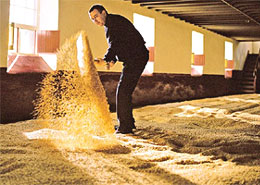Malt is the backbone of your homebrew. Not only does it contribute flavor to your beer, but it’s also responsible for fermentable sugars, color, aroma, and mouthfeel. Below are a number of terms used when talking about malt and how it’s made:
is the backbone of your homebrew. Not only does it contribute flavor to your beer, but it’s also responsible for fermentable sugars, color, aroma, and mouthfeel. Below are a number of terms used when talking about malt and how it’s made:
- Two-Row/Six-Row – There are two types of barley that are grown for brewing: two-row and six-row. The names refer to the way the grains grow on the stalk. Learn about the differences between two-row and six-row barley in this blog post.
- Endosperm – The endosperm is the white, starchy part of the malt grain that contains the carbohydrates which are converted into fermentable sugars during the malting and mashing processes. It’s important to expose this part of the grain when crushing it in order to promote good brewhouse efficiency.
- Germination – Germination, the second step in the malting process after steeping, is simply the act of sprouting. Barley grain must germinate before it can be turned into malt.
- Acrospire – During the malting process, the barley grain begins to grow. The acrospire is the shoot that would turn into a barley stalk if it were allowed to continue growing. Maltsters monitor the length of the acrospire as an indication when the grain is ready for kilning.
- Enzymes – One of the important characteristics of malt is that it contains enzymes. These enzymes (produced during germination) are what help the brewer convert starches into fermentable sugars during the mashing process.
- Modification – During germination, modification is an indication of when activity inside the barley grain is complete. Some malts are referred to as “well-modified” or “less-modified.” Most commercially produced malt is well-modified.
- Degrees Lovibond – Named for its inventor Joseph Lovibond, this is a number which describes the color of malt. Base malts, such as Pilsner malt, may be as low as 1 ºL, whereas heavily roasted malts can be as high as 300-500 ºL.
- SRM – Beer color, which is largely influence by the types of malt in a beer recipe, is measured by SRM, or Standard Reference Method, units. 1 is very pale; 40 and higher is black. An SRM Calculator can easily estimate the color of your homebrew.
- Base Malt/Grains – These malts form the majority of the grains you use in your homebrew. They are generally light in color and must possess Diastatic Power, a number which measures the enzyme content of malt. Examples of malt that can be used as base malt include 2-Row Brewer’s Malt, 6-Row Brewer’s Malt, Pilsner Malt, Vienna Malt, and Munich Malt (10L).
- Specialty Malt/Grains – Specialty malt, such as caramel malt and roasted barley, are used to contribute color and flavor to your beer. Because they contain little to no enzymes, they need to be mashed with base malt in order to extract their fermentable sugar.
- Adjunct Grains – Adjunct grains are those grains other than barley that are used to add gravity, improve body or head stability. Examples include wheat, rye, corn, and oats.
- Milling – The process of crushing your malted grains for brewing.
These are most of the homebrewing terms you should know involving malted barley grains and the malting process. Are there any homebrewing terms you’d like to learn more about? Leave a comment below!
————————————————————————————————————
David Ackley is a beer writer, brewer, and self-described “craft beer crusader.” He holds a General Certificate in Brewing from the Institute of Brewing and Distilling and is founder and editor of the Local Beer Blog.
